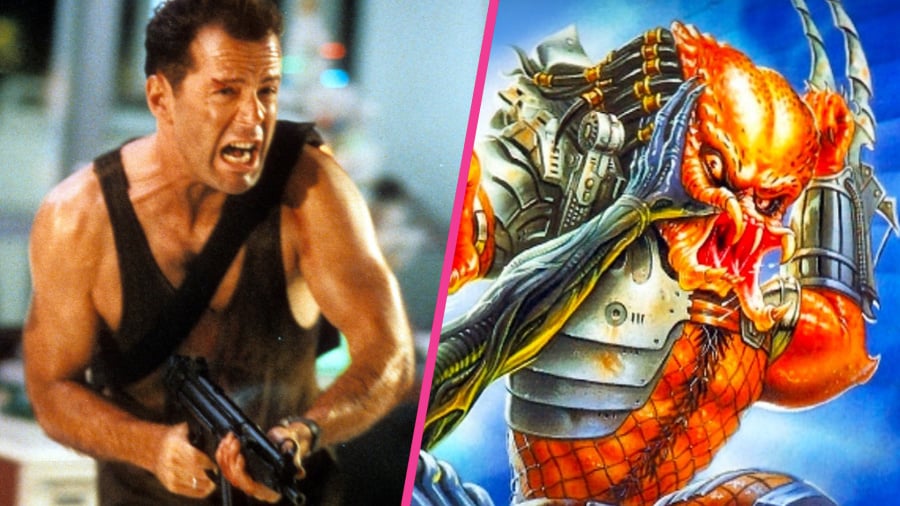
Something we don't see a lot of anymore are game adaptations of films. There might be a few still, especially if under a large IP umbrella like Marvel, but it's nothing compared to the 1990s when seemingly every film had a chance at becoming a game. UK publisher Ocean was famous for producing these, and its story is fairly well documented. What's less documented is the Japanese side of film-to-game adaptations. As it turns out, even if a game's credits may imply it was Western developed, such as Die Hard on NES, it may actually have come from Japan. But to disentangle this untold history, we need some inside sources.
Bill Swartz and Kelly Rogers were both interviewed for The Untold History of Japanese Game Developers, given that when they both worked at Activision, they were involved in the localisation and publishing of Japanese SNES shmup BioMetal, by Athena. You may remember BioMetal as that game with the officially licensed 2 Unlimited soundtrack. Given that both Activision interviewees were credited on the sublime Die Hard for NES – designed by Tony Van and yet attributed to Pack-in-Video – naturally, they had to be grilled on this too!
Die Hard on NES is a top-down action-adventure that closely follows the film and, at a glance, resembles Zelda or Metal Gear. It's also one of the best games on the NES, with a line-of-sight visual system where rooms and enemies are only displayed if your character is facing them, a dynamic weapons system where you can sacrifice your machine gun to access air ducts, inventive item functionality facilitating optional goals and multiple endings, and an organic (almost procedurally-generated) game flow as enemies react to your actions and the floors you're on. In 1991, there was little else like it – the game feels almost alive.
"This was one of my first titles as a full-time tester - I might have been lead tester, in fact," says Rogers, fondly. "I loved this game! It was really fun to play with great immersion in the environment as you point out. It had kind of a 'lighted cone' thing, for your field of vision. When you moved, it would show in 2D just what your character was seeing. Testers loved Die Hard on NES; it added a level of realism not often used in games at that time, since the First-Person Shooter format had yet to be fully realised. Ton Van was designer. He worked most directly with Pack-in-Video."
You may recognise Tony Van as the man behind Shadowrun on the Mega Drive (there's even some slight similarities between Die Hard and Shadowrun). Sega-16 had a lengthy interview with him in 2005. Sadly it's been impossible to contact him again, even after a personal introduction from Sega-16 founder Ken Horowitz. Mr Van, if you're reading this, Time Extension would love to chat.
Which leads us to Activision Japan's former Managing Director, and later Activision US' Senior Vice President, Bill Swartz. "Activision Japan, previously Mediagenic Japan, had been around for a long time," says Swartz. "I took it over in 1990 and ran it until 2000, and I'm happy to say for at least 8 of those 10 years it was the first or second most profitable Activision operational unit. Activision Japan did a number of things, including sales of Activision properties, licensing, development, and publishing."
Swartz was also credited on Die Hard, alongside Rogers. "For Die Hard, make sure you talk to Tom Sloper," suggests Swartz. "Tom was a producer at Mediagenic and managed that product in Japan for a few months. We actually overlapped in Japan briefly. One of the Die Hard titles - again, this was before me, but might have been Mega Drive? - was slopped together overnight by Pack-in-Video switching sprites with one of their other titles because they hadn't touched it for the year they were supposed to be developing it."
Reskinning an already existing game in development to match an acquired license happened frequently in game development, so shouldn't be surprising. What is surprising is the mention of a Mega Drive version, since the only Japanese-developed Die Hard games by Pack-in-Video were for the NES and PC Engine. While possible Pack-in-Video developed a Die Hard for Mega Drive which went unreleased, Swartz's description definitely sounds like the PC Engine game, which featured McClane wading through swamps and other stuff not in the movie. A hasty reskin of a mid-development action game seems a plausible and logical explanation. We sent a YouTube link to Swartz, showing the PC Engine version, asking if he can confirm it, to which he replied: "I think so, but I'm afraid I could not swear to it."





